
Pietralunga, a small, but picturesque, medieval town, originally a Roman settlement, is located approximately 25 kilometres east of Citta di Castello and approximately 35 kilometres north of Perugia.
Encircled by ancient walls, the town centre with narrow streets offers a selection of many excellent restaurants renowned for their Umbrian cuisine including the Trifola or White Truffle, Gnocchi con Tartufi, the Cappelletti, the Tortciglione, the famous Potato of Pietralunga, and a variety of local cheeses. At the heart of the town are the ruins of the Rocca Longobarda, an 8th-Century Lombard fortress, and the beautiful Church of Santa Maria with an elegant Romanesque portal dating from 1279 AD.
Outside the walls are the Sanctuary of the Madonna dei Rimedi and the Church of the Saddi, an early Christian basilica, built around a crypt, where the tomb of St Crescenziano was originally located. The church also houses a fine 8th-Century bas-relief of St Crescenziano killing a dragon. The Natural History Museum and the Candeleto Oasis are worth a visit.
During July, Pietralunga hosts a popular annual Beer Festival which attracts visitors from near and far.
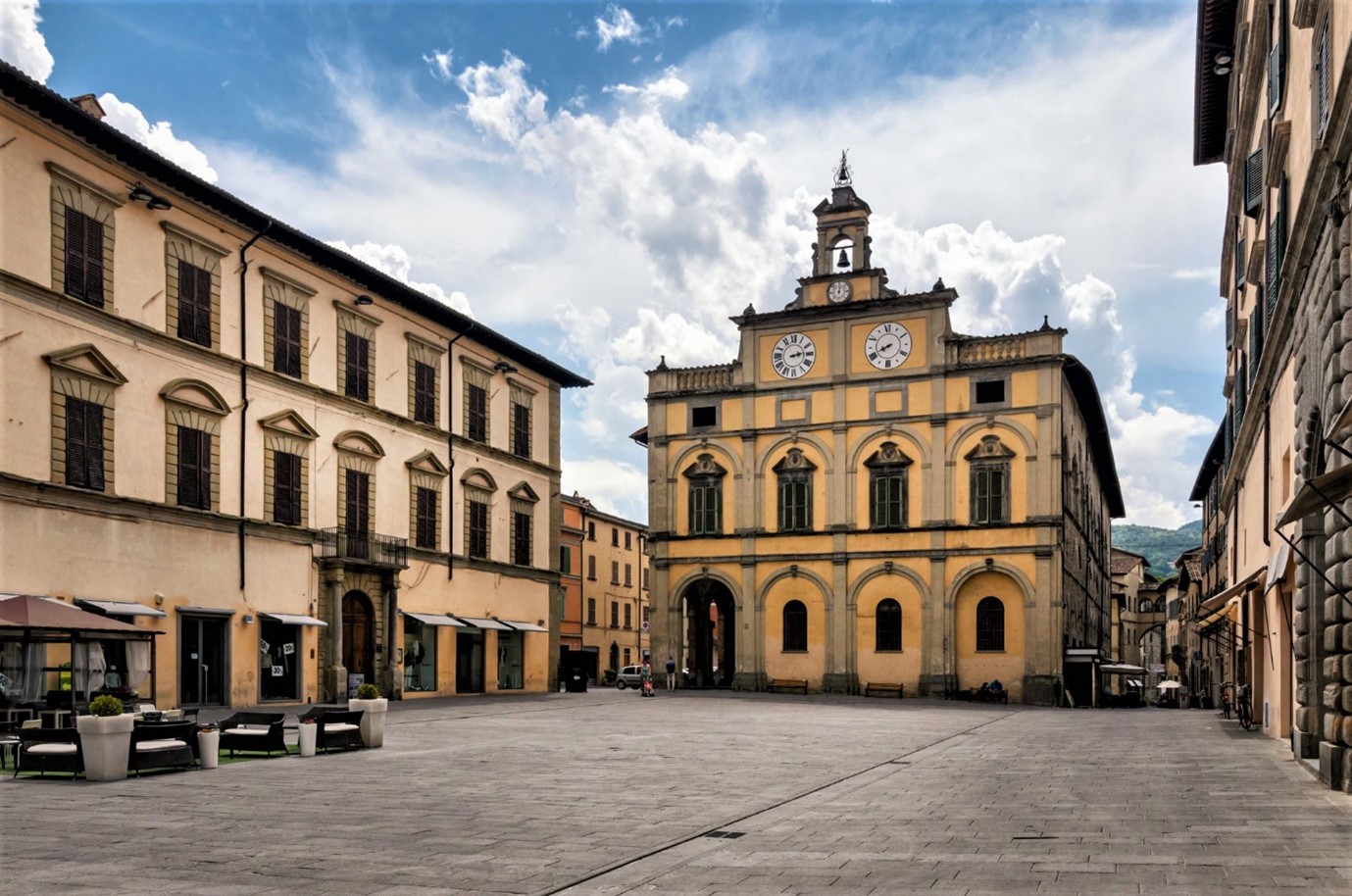
Citta di Castello, situated in the north of Umbria near the borders with Tuscany and Marche, was known to the Romans as Tifernum Tiberinum (“Tifernum on the Tiber”) and changed hands many times over the centuries until 1861 when it became part of the Kingdom of Italy.
Surrounded by rolling green hills, the town’s substantial walls remind visitors of past conflicts. The heart of the town is Piazza Matteotti dominated by the Palazzo del Podesta and the Palazzo Vitelli a Sant’Egidio. From the piazza, a network of streets leads to the Duomo, museums, churches, and several other palaces including Palazzo Albizzini, and Palazzo Bourbon del Monte on Piazza Costa.
Citta di Castello boasts of its many restaurants specializing in local delicacies and also shops selling a variety of products. Many of the restaurants are located down quaint narrow streets and alleyways and are well worth the time spent exploring the historic centre to find a restaurant of your choice to enjoy the Umbrian cuisine and the excellent local wines.
On the outskirts of the town is the Centro Commerciale with a well-stocked and extensive supermarket, a pharmacy, and shops selling a variety of products including electronics, clothes, shoes and with a café.
Citta di Castello is approximately 55 kilometres north of Perugia.

Montone, a small medieval town north of Perugia, is located on a hill between the Carpina and Lana Rivers, both tributaries of the nearby Tiber, Italy’s longest river, on its meandering journey from the Alps to Rome.
This beautiful town offers beautiful panoramic views over the surrounding countryside with a backdrop of forested hills and mountains. Within it’s walled historic centre, picturesque narrow streets meander between ancient stone-walled houses throughout this beautiful small town. From the central square, a striking stairway leads to the gothic Church of San Francesco built in the 14th-Century. An adjacent Franciscan monastery, recently restored, now houses a municipal museum. At the foot of the hill is the Pieve Vecchia, a Byzantine-Romanesque building erected in the 11th-Century.
Despite being small in size, Montone offers several excellent restaurants to select the cuisine of your choice, including La Locanda del Capitano, Tipico Osteria dei Sensi, and Taverna del Verziere.
Montone is approximately 22 kilometres south of Citta di Castello.
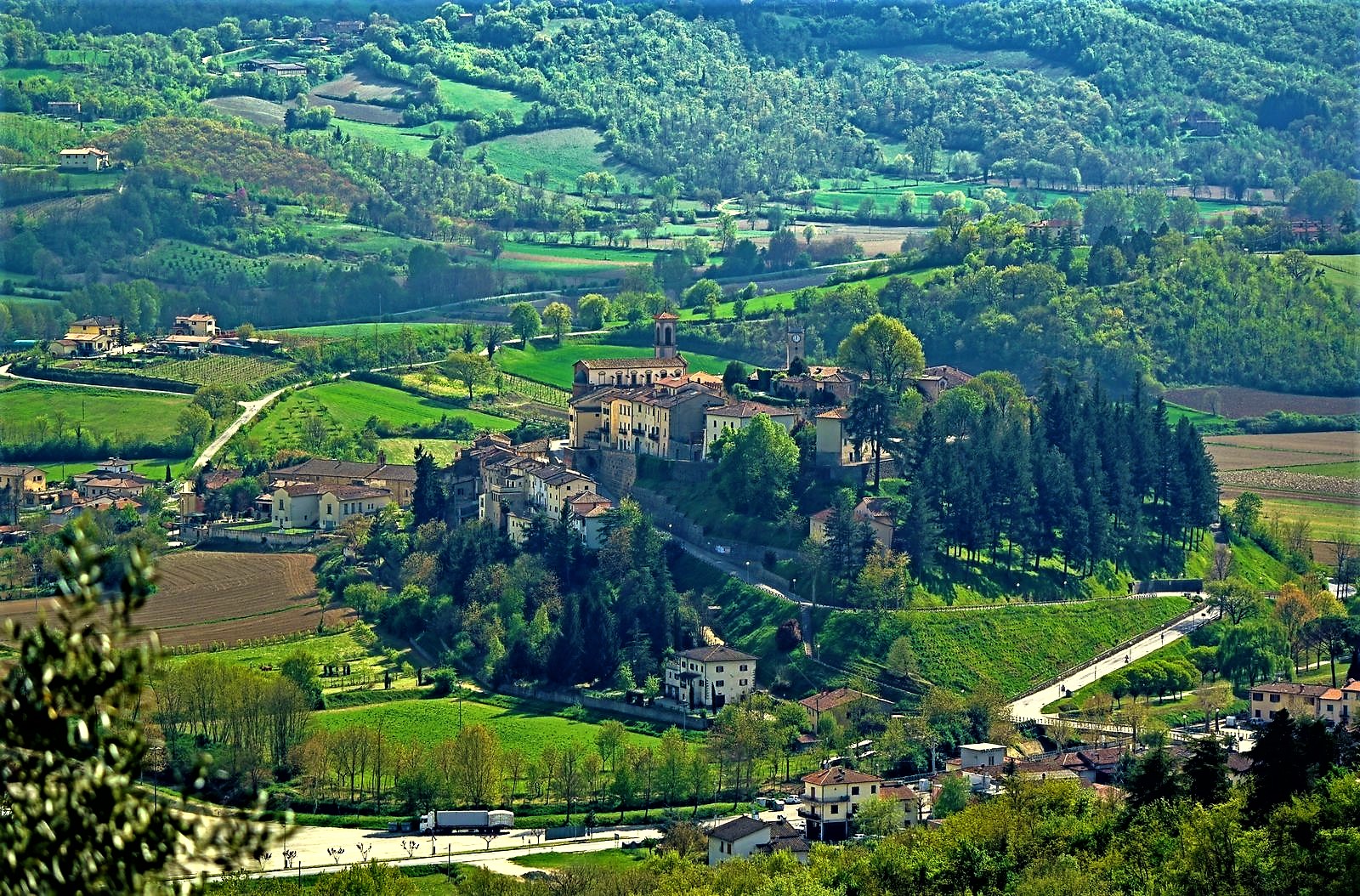
Monterchi. just 19 kilometres west of Citta di Castello, is a the hilltop medieval town incredible views across the surrounding beautiful Tuscan countryside of the Tuscan Valtiberina dotted with churches, monasteries, and hermitages.
Massive encircling walls still partially remain from the fortifications which protected this small town and its inhabitants from the invading hordes following the decline of the Roman Empire and the following centuries. The narrow streets and alleyways are dotted with the village cafes and small workshops, and the Museo della Madonna del Part di Parti where the famous Madonna del Parto fresco is displayed. This masterpiece fresco painted in 1459 by Piero dell Francesca, one of Italy’s greatest painters of the 15th-Century, was originally on the wall of the local chapel of Santa Maria a Momentana from where it was removed before being installed in the museum.
Cultural, musical, and gastronomical festivals are held during the summer months at the foot on the hill culminating in the popular Polenta Festival taking place on the penultimate weekend in September.
Only a handful of restaurants are available in Monterchi. Senza Tempo in the historic centre of the town offers excellent pasta and typical local dishes, and at a high point with great views is Una Terrazza in Toscana, a restaurant with no frills but delicious home-cooked food – the tagiatelle with truffles, porcini and sausages is to die for, a choice of local wines and at reasonable prices.

Umbertide is renowned for the magnificent medieval fortress, the Rocca, which overlooks the vast Piazza Mazzini in the historic centre of the town, located just off the E45 and only 22 kilometres south of Citta di Castello.
The town is home to several churches, including the unique octagonal Church of Santa Maria della Reggia, the beautifully restored Church of Santa Croce and the Churches of San Bernardino (built in 1556), Santa Maria della Pieta (built in 1486), and San Francesco dating back to 1299.
Nearby is the magnificent Civitella Ranieri Castle rebuilt in the 15th-Century after its destruction during the earlier wars between the Oddi and Baglioni families. There are also many other castles and churches in the vicinity of Umbertide well worth visiting.
In addition to an indoor market and many shops selling a variety of goods, Umbertide and the hamlets surrounding the town also offer many excellent restaurants providing a wide choice of cuisine.
Just a few minutes driving time from Umbertide in the picturesque Niccone Valley, is Ristorante Girasoli offering day-by-day handmade fresh pasta and deserts, fresh vegetables including truffles and mushrooms, seasonal-only fruits, local meat, delicious cheeses, and excellent wines from local vineyards. This is an excellent venue for an outdoor lunch.
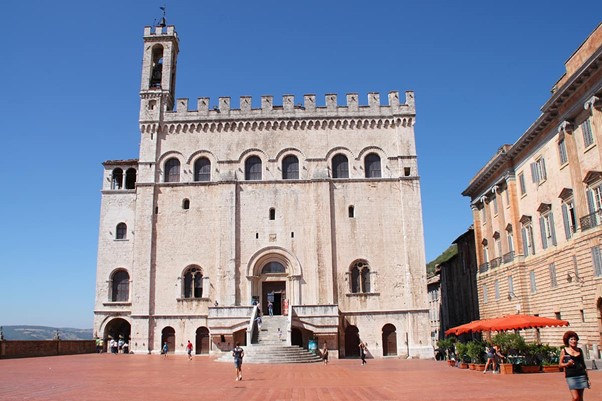
Gubbio, a small but beautiful medieval stone-built town with distinctive towers and magnificent buildings, perched on the steep slopes of Mount Ingino, offers fabulous panoramic views over the picturesque valley below.
Piazza Grande lies at the heart of Gubbio edged by palaces and towers of past rulers and dignitaries. The steep and narrow streets meander between buildings of yellow stone roofed with red Roman tiles, with restaurants, shops offering a multitude of goods including locally produced ceramics.
Overlooking the Piazza Grande is the imposing Palazzo del Consoli, built during the early 14th-Century and now the home to the Museo Civico with an impressive collection of inscriptions, fragments, statues, and marblework from Roman times and the early medieval period. Dominating the town is the magnificent Palazzo Ducale built in 1470 with two central buildings, one facing the valley and the other towards the mountain, and with a splendid central courtyard, the Corte d’Onore.
Just outside the city walls, there is a well-preserved Roman theatre dating back to the reign of Augustus Caesar situated just outside the city walls on the lower slopes. The Abbey of Sant’Ubaldo situated on the mountain above the town is worth a visit.
Gubbio is approximately 21 kilometres south of Pietralunga.
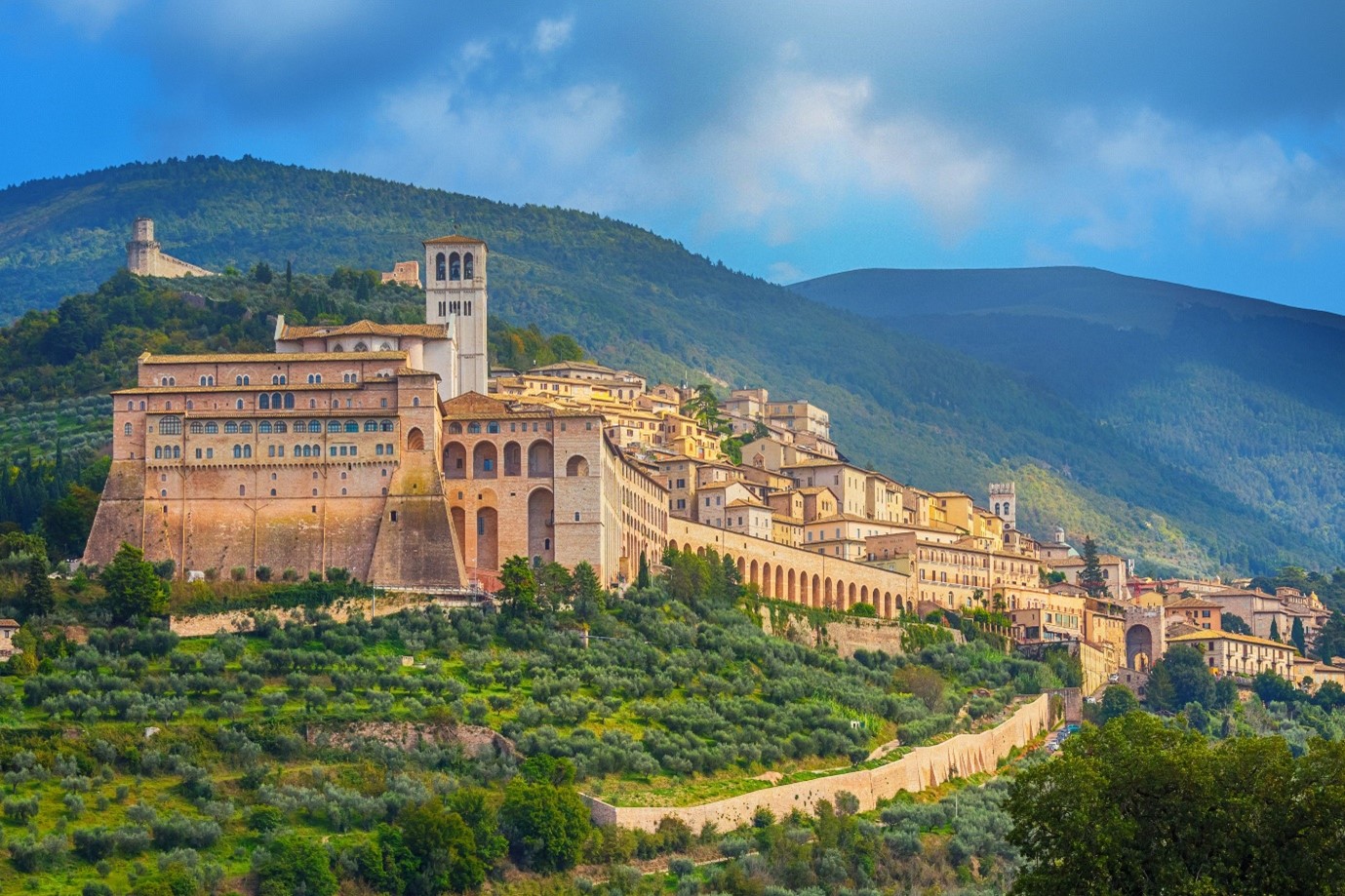
Assisi, the birthplace of St Francis in 1182, is a breathtaking and astounding sight greeting all visitors as they approach this beautiful walled town built in pink and white stone located in an impressive setting in the Valle Umbria on the slopes of Mount Subasio. The magnificence of the 13th-Century Basilica of San Francesco rising from the mountainside is an incredibly imposing spectacle. The Basilica contrasts dramatically with the narrow and quaint streets with Roman ruins and sacred shrines winding through the city now offering restaurants in unusual locations and numerous shops offering art, linens, religious artifacts, and souvenirs of Assisi.
In addition to the Cathedral of San Rufino and Santa Maria Maggiore, the oldest church in Assisi, this beautifully preserved medieval town is home to many other churches and monasteries and also with 2 castles including the massive Rocca Mggiore built by Cardinal Albornoz dominating Assisi and the Valley of Tescio. Located in the centre of the town is the beautiful Piazza del Commune with the Roman Temple of Minerva built in the 1st-Century but since transformed into the Church of Santa Maria sopra Minerva. Several small piazzas are sited throughout the town.
Over the first four days in May, the annual Calendimaggio Festival, an enactment of Medieval and Renaissance life, takes place with processions, flag waving, dancing contests, choirs, theatrical presentations, and crossbow competitions.
Assisi is approximately 67 kilometres south of Citta di Castello.
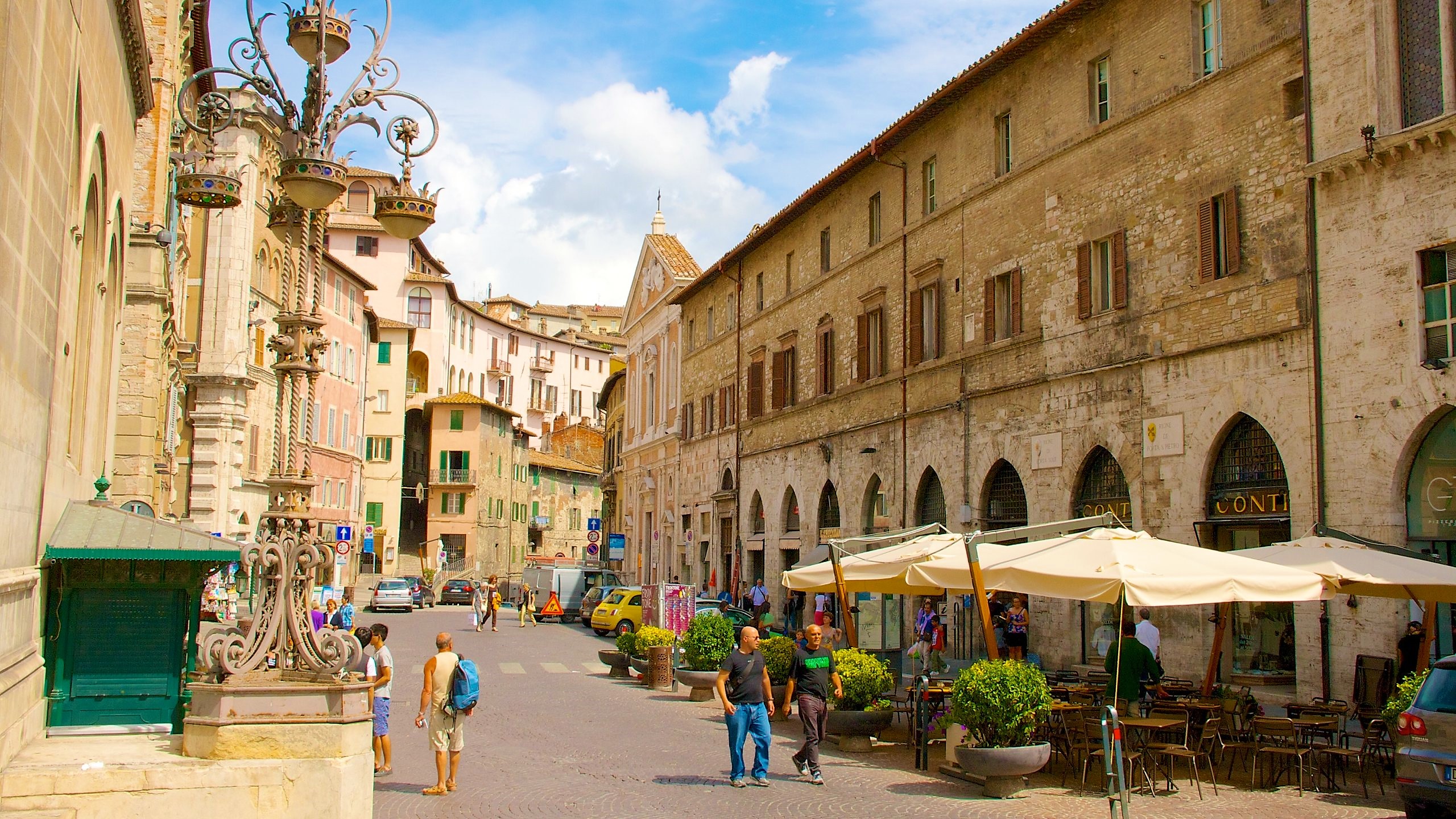
Perugia, Umbria’s Capital and largest city with a massive Etruscan wall and gateways dating back to the 6th-Century BC, dominates the surrounding area from its elevated location providing panoramic views over the surrounding countryside.
Perugia is today a thriving commercial centre offering superb shopping and restaurants. Many can be found in Corso Vannucci, a busy and elegant street leading to the Piazza 1V Novembre, situated in the heart of the city and the hub of the city’s network of streets offering hidden treasures to intrepid visitors. This piazza is considered as one of the grandest in Italy with its magnificent Medieval buildings which include the Palazzo del Priori housing the Galleria Nationale dell’Umbria, the gothic Cathedral, and the Fontana Maggiore – the Great Fountain built in 1278. Leading from the piazza is the picturesque Via Maesta delle Volta with its vaulted passageways and medieval houses some converted into restaurants and shops.
Beneath today’s Perugia lies the “buried city”. The subterranean Via Bagliona provides a unique opportunity for visitors to view the underground structures of the Rocco Paolina with ancient streets, warehouses, courtyards, and small piazzas. Walkways, tunnels, and moving stairways lead from Piazza Parigiani to Palazzo della Provincia in the Piazza Italia giving an archaeological journey into medieval Perugia.
Perugia hosts the annual music festival, Umbria Jazz Summer, in the historic heart of the city during the first 10 days in July.
Just off the E45 at Perugia, is the Centro Commerciale Collestrada, a superior shopping mall with a huge supermarket and many superb shops offering the best of Italian goods and fashion.
Perugia is just 171 kilometres north from Rome and 55 kilometres south of Citta di Castello.
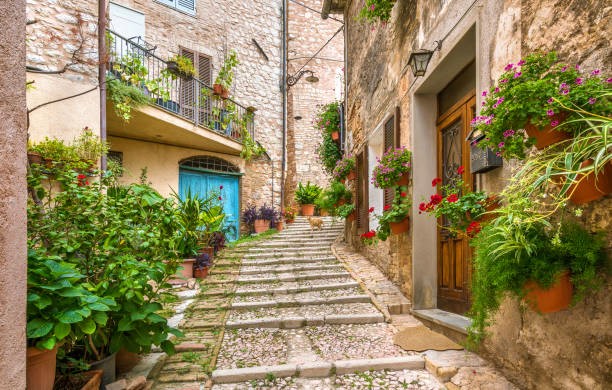
Trevi, a small, picturesque medieval town situated on the slopes of Monte Serano offers one of the best views in Umbria over the wide fertile plain below dotted with farms, villages, countless waterways and rivers, and centuries-old olive groves.
The town is encircled within two sets of medieval walls enclosing Piazza Mazzini, palaces, towers, medieval churches and two museums, the Museo S Francesco with a collection of Umbrian painting from the Middle Ages, and the Museo della Civilta dell’ Olivio giving the story of the olive from planting and cultivating to processing into top quality extra virgin olive oil.
There are a number of good restaurants in Trevi including Ristorante L’Ulivo, La Cucina di San Pietri a Pettine, Locanda Castellina, and Ristorante Maggiolini. Just outside Trevi there are many more specializing in Umbrian cuisine with a few offering a “tasting menu.” Local speciality dishes include Cazzimperio, a combination of extra virgin olive oil and black celery, pork sausages, pecorino cheese and honey, soups and salads.
Trevi is host to a 3 week-long music festival every year during August but the main festivals taking place annually on the first, third, and fourth Sunday in October.
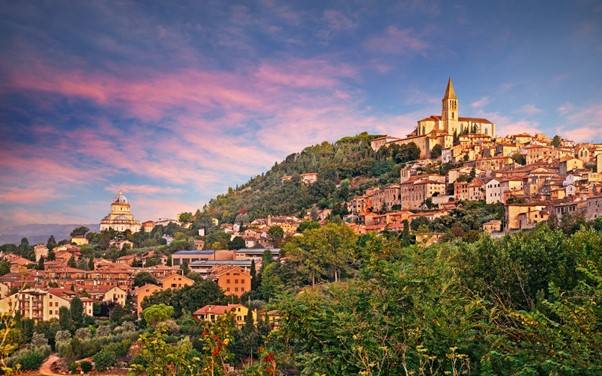
Todi perched at the peak of a high hill overlooks the River Tiber and offers incredible panoramic views in all directions over the surrounding countryside dotted with isolated hamlets, olive groves, fields of yellow sunflower, and rolling farmland.
The town is encircled by massive walls, a conglomeration from Etruscan, Roman and medieval times. Steep narrow streets meander from the piazzas like a spiders web from the piazzas with shops, cafés and restaurants offering many speciality dishes including wild boar stew, Castelluccio lentis, Formaggio di Foosa, a sheep’s milk cheese wrapped and aged underground, and fresh woodland vegetable, wild herbs, fruits, and truffles.
Todi’s ancient monuments include the Duomo built in 1190 on the site of a Roman temple dedicated to Apollo; one of Italy’s most photogenic piazzas the Palazzo del Popolo built in 1213; the Palazzo del Capitano and the Palazzo dei Priori both built in 1293; the Palazzo Vescovile built in 1593; an imposing domed Renaissance church, Santa Maria della Consolazione; plus other churches and renaissance buildings. There is also the Nicchioni, a colossal Roman structure overlooking the Piazza del Mercato Vecchio, and the ruins of a Roman amphitheater.
Like most Umbria towns, Todi offers a Saturday Market offering fresh produce and traditional Umbrian food.

Spello, another picturesque ancient stone built town located on the southern slopes of Mount Subasio and just 10 kilometres from Assisi, is famed for having more visible remains of the Roman times than any other town or city in Umbria.
Spello is totally encircled by massive walls including several city gates – Porta di Venere with its 3 arches defended by 2 twelve-sided towers, Porta Consolare with 3 arches, and the Arch of Augustus dating back to the 1st Century BC, Porta Romano, Porta San Sisto, and Porta Urbica. Well preserved remnants of the Forum can be seen between Piazza Sant’Andrea and Piazza della Replublica. On the outskirts is a partially excavated Roman amphitheater, the Villa Fidella with its splendid grounds including the Vesuvian Garden, the Exedra Fountain, and the Cypress Grove. There is also a large building complex, discovered in 2005, with a well-preserved mosaic floor and frescoed walls.
Inside the walls are impressive palaces, churches, and museums, including Palazzo dei Canonici with a public art gallery, Palazzo Comunale Vecchio on the Piazza della Republica, Palazzo dei Consoli on Piazza Silvestri, Palazzo Baglione, the Church of Santa Maria Maggiore, the Church of San Lorenzo, and the Church of Sant’Andrea.
In the narrow streets of this small ancient town, there are many speciality shops and excellent restaurants such as the Ristorante Porta Venere, Osteria De Dada, La Cantina di Spello, Il Pinturicchio, and Osteria del Buchetto.

Spoleto, an ancient town some 62 kilometres south-east of Perugia, is renowned for its historical buildings. These include the magnificent and formidable castle the Rocca Albornoziiana, the Cathedral of Santa Maria Assunta, the beautiful Palazzo Racani Assoni, and the dramatic Ponte delle Torri a 13th Century aqueduct.
Roman ruins include the amphitheater dating back to the 2nd-Century, the restored Casa Romana di Vespaia Polla built around an atrium with well-preserved beautiful mosaic floors and frescos, and the Arco di Druso built in 23 A.D. to commemorate the death of Emperor Tiberius’s son Drusus was the entrance to the Roman Forum. The site of the Forum is now home to one of Spoleto’s central squares, the Piazza Del Mercato with cobblestone streets running from it in all directions. The Teatro Romano houses a well-worth visiting museum with exhibits telling the Roman history of the town.
Spoleto offers visitors a wide selection of excellent restaurants including Il Tartufo, Albergo Ristorante La Macchia, Eremo delle Grazie, and Trattoria del Festival serving regional and traditional Italian dishes. There are also many cafés, pizzerias, and gelatos to be found, together with plenty of shops selling many products including clothes, jewelry, locally produced terra cotta, pottery, and varieties of good local wines.
The famous 17-day Spoleto Festival, also known as the Festival of the Two Worlds, bringing together European and American cultures, is held during annually in late June/early July. This festival is one of the important cultural events in Italy, featuring operas, concerts, dance including ballet, music, recitals, and contemporary art.
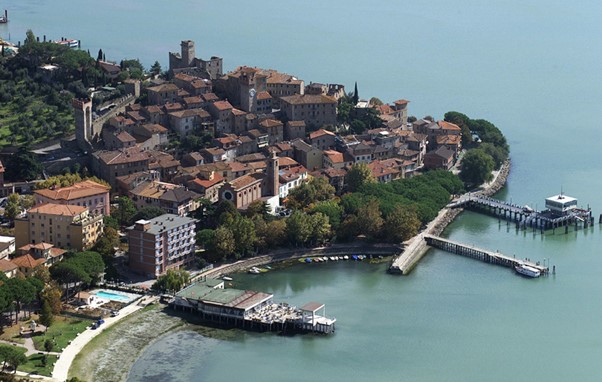
Castiglione del Largo, a small town located on the south-west shoreline on beautiful Lake Trasimeno, has been disputed territory over the past 2,000 years due to its location. The town originally covered a small island but over centuries as the town grew after the 13th-Century, it was joined to the mainland with the construction of churches, piazzas, houses, and other buildings. The well-preserved historical centre contains the Palazzo della Corgna, which now houses a civic museum and gallery with late Renaissance frescos and paintings. The palazzo is connected by a long, covered tunnel to the Fortress of the Lion, a pear-shaped castle featuring square towers in each of its four corners and a triangular shaped bastion. The castle completed in 1247, was intended to give Emperor Frederick 11 strategic control over Lake Trasimeno and withstood many sieges over the following centuries.
The town hosts the annual Coloriamo i Cieli Festival in late April/May and includes many light aircraft, up to 20 hot air balloons, and thousands of multi-coloured kites. Prior to the annual music festival held in Perugia during the first 10 days in July, the towns bordering Lake Trasimeno play host to smaller festivals dedicated to the music of New Orleans, the birthplace of jazz.
Lake Trasimeno is a refuge for birds and is good sport for anglers with an abundance of pike, carp, and tench.
Lake Trasimeno was the scene of the famous battle between two Roman legions and Hannibal of Carthage in 217 BC, resulting in total annihilation of the Roman legions.
Castiglione del Lago is situated approximately 67 kilometres south-west of Citta di Castello.
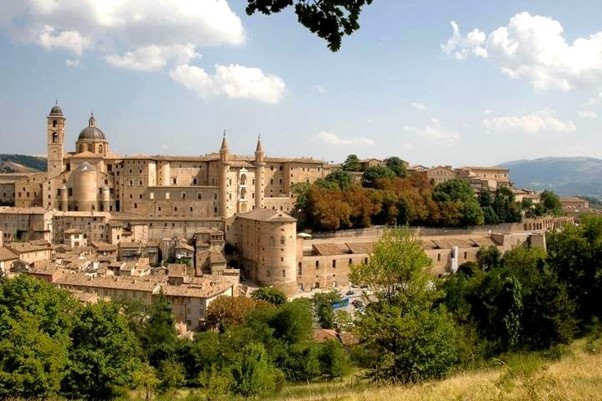
Urbino, the capital city of Marche lies over the mountains from Umbria just 56 kilometres north-east of Pietralunga. Urbino is one of the most important Renaissance sites in Italy and a UNESCO World Heritage Site.
The defensive walls of Urbino encircle the magnificent Palazzo Ducale built in the 15th Century and now housing the Galleria Nazionale delle Marche, one of the most important collections of Renaissance paintings in the world ; the Duomo built originally in 1021 but rebuilt in 1801 with a soaring dome; the Albornoz Fortress built in the 14th Century dominating the city; the family house of Raphael now a museum/shrine with monument erected in 1897; the Pierina Scaramelia Botanical Gardens, and the churches and oratories of Sant’Agostino, San Francesco, San Giovanni Battista, and San Giuseppe. There are also museums to visit.
With the multi-national students attending the famous University of Urbino founded in 1506, the city is full of life with numerous bars, cafes, and restaurants in and around the piazzas. La Crescia sfogliata is a speciality well worth adding to your must-eat list.
Opposite the Palazzo Ducale and alongside the Fortrezza Albornorz is the Parco della Resistenza, a lovely park to sit, relax, and enjoy the magnificent views over the rooftops of Urbino.
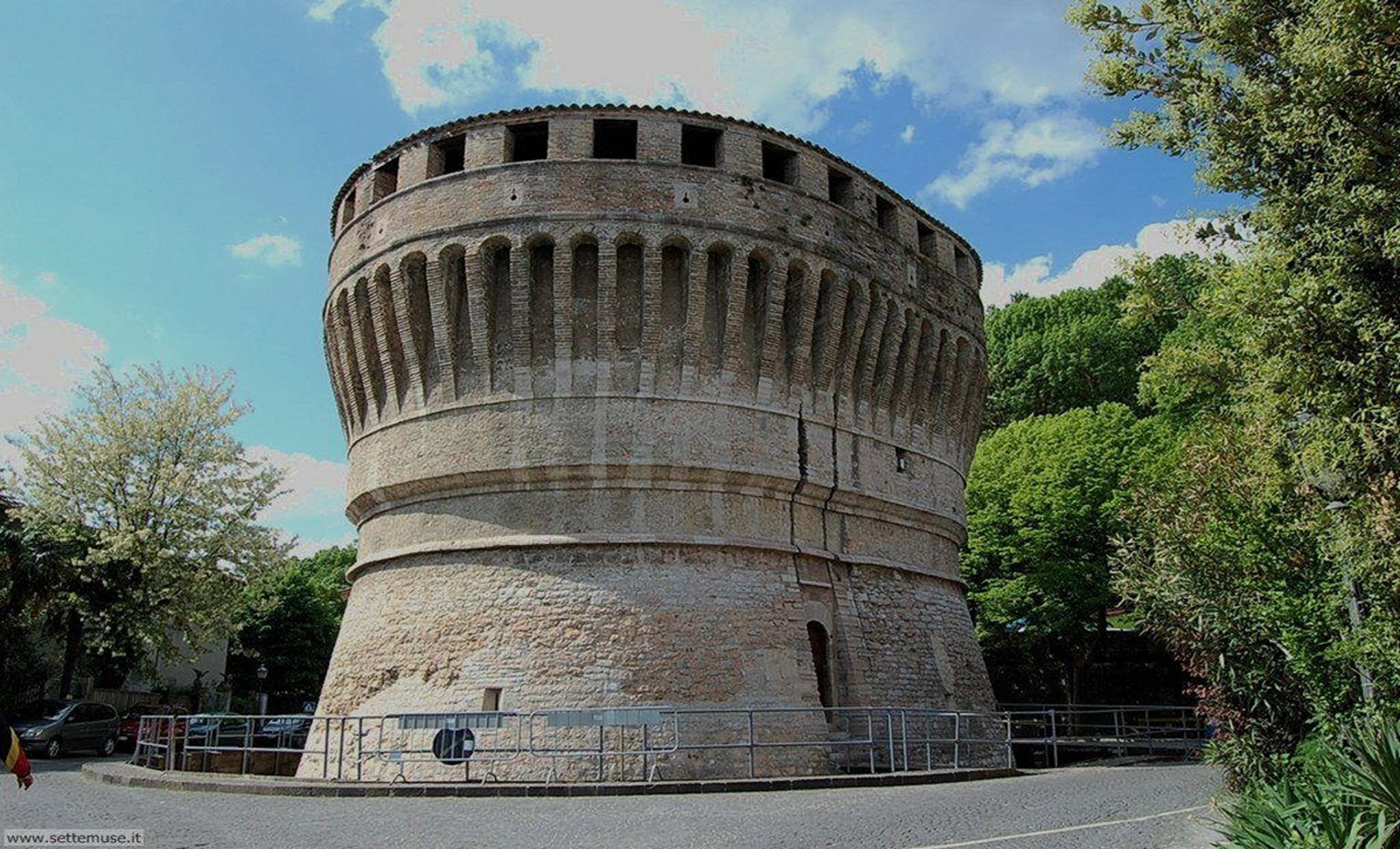
Cagli is set in natural splendour with the twin peaks of Monte Catria and Monte Acuto to the east, and alpine meadows broken up by woods of beech trees. In all direction Cagli is surrounded by the grandeur of the mountain range of the Central Apennines and in late spring, the upland meadows are carpeted with a mass of wild daffodils and during May and June, they are a spectacular sight being in full bloom with alpine flora.
This little town was originally a staging post on the Via Flaminia, one of the oldest and most important Roman roads in Europe, and still today retains the original Roman grid plan with all roads leading to a central square, Paizza Matteotti. The dramatic oval tower, Rocca Torrione, a remnant of the citadel built in the 15th Century, dominates the town, whilst the piazza is dominated by the Palazzo Pubblico and the Palazzo del Podesta. The Duomo, impressive with its bell tower and rounded vault replacing the earlier tall dome, contains works of art including painting, frescos, and canvasses. Other churches include Church of San Domenico built in 1289 with painting by Giovanni Santi, father of Raphael, the Church of San Giuseppe with a barrel-vaulted interior decorated with stucco-work, and the Church of Santa Maria della Misericordia. In the town are also the Ponte Mallio an imposing Roman bridgee dating back to 220BC, and the Palazzo Berardi Mochi-Zamperoii.
Annual events include Distinti Salumi when the town hosts a celebration of Italian and International charcuterie at the end of April; Corpus Christi Procession when the streets are carpeted with flowers; Procession of Cristo Morto held in late afternoon of Good Friday; and Palio and Gioco dell’Oca competition dating back to rivalries between Cagli’s historic quarters in 1543 which takes place on the 2nd Saturday in August.
For lovers of good food, Cagli provides opportunities to choose from many excellent restaurants and offers local dishes based on venison, mushrooms, and truffles.
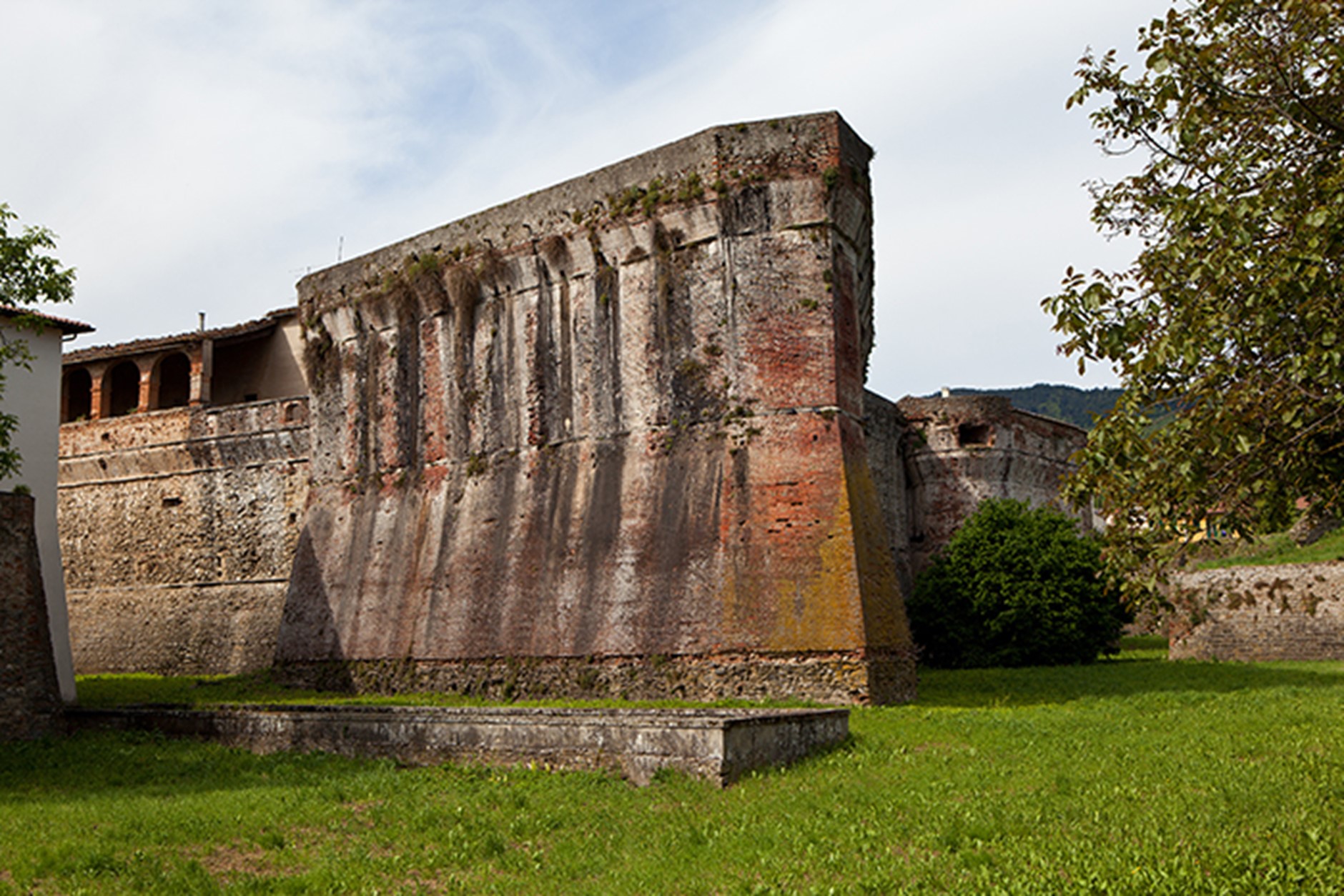
Sansepolcro surrounded by rolling hills, is located in Tuscany just across the border with Umbria. The town was founded in the 11th Century, and is famed as the birthplace of the painters, Piero dell Francesco, Raffaellino del Colle, Matteo di Giovanni, Santi di Tito, and Angioli Tricca.
The entrance into the historic centre is through the ancient walls which encompass the old town. In the heart is the main square, the Piazza Terre di Berta with the 13th Century Giovagnoli Palazzo, the 14th Century Duomo, the 16th Century Pichi Palazzo, and the Palazzo delle Laudi. The museum and Art Gallery houses an impressive collection of 15th and 16th Century paintings. Other imposing and historic buildings are within walking distance from the piazza.
Sansepolcro offers various activities and events throughout each year. These include the famous Palio della Batestra, featuring the crossbowman of the town competing against rivals from Gubbio, taking place in September, and also the mid-Lent Fair, the Fiera di Mezza Quaresima, promoting local products and handicrafts.
There are many restaurants including Ristorante da Vasco, Ristorante al Coccio, Albergo Ristorante da Ventura, and the Pasticceria Chieli serving delicious pastries, chocolates, and coffee.
The Tuscan Valtiberina is dotted with churches, monasteries, hamlets, and hermitages including the Hermitage of Montecasale.
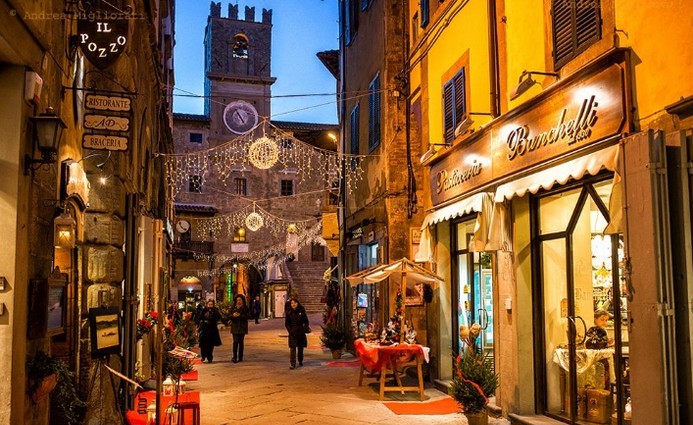
Cortona, was the setting for the Frances Mayes book “Under the Tuscan Sun” and was featured extensively in the renowned movie of the same title.
This gorgeous medieval town situated 46 kilometres south-west of Citta di Castello and just across the border from Umbria into Tuscany, is enclosed by stone walls. Like some many other Tuscan and Umbrian towns originating from the Etruscan and Roman times, it occupies a commanding position on a hilltop with superb panoramic views over the Valdiciana.
Steep narrow streets meander down from the Piazza Garibaldi aka Piazza Carbonaia, from where visitors can enjoy a view of Lake Trasimeno. The Palazzo Casali houses the Museo dell’Accademia Etrusca with displays of artifacts from the Etruscan, Roman, and Egyptian civilisations, and with many more from the Medieval and Renaissance eras. The many splendid churches include the Santa Maria delle Grazie al Calcinaio built between 1484 to 1515 and the domed Santa Maria Nuova built in 1554. At the highest point of Cortona are the beautiful Santa Margherita Sanctuary and the Girifalco Fortress.
The Festival of Giostra dell’Archidado takes place annually in late May/early June. This week-long costume event re-enacts the wedding of Francesco Casali, Lord of Cortona, to Antonia Salimbeni of Siena in 1397, and includes stalls selling medieval food, medieval dinners, and with entertainment typical of medieval times including a crossbow competition between the five districts of Cortona.
There are many restaurants in the city offering traditional and Tuscan cuisine. Small shops are also to be found in the narrow streets offering locally produced products and superb wines, with the vineyards of Montepulciano and Montalcino being just a few kilometres away.
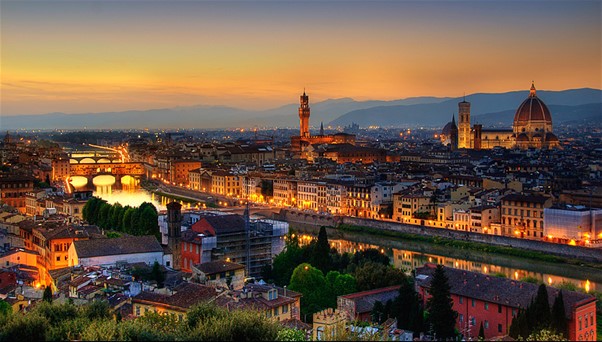
Florence, the birthplace of the Renaissance and home to the Medici family, was one of the wealthiest and powerful cites of the Medieval era and includes numerous palaces, churches, museums, art galleries, and theatres.
The palaces include the Palazzo Vecchio overlooking the Piazza dell Signoria, the Loggia dei Lanzi, Palazzo Medici Riccardi, Palazzo Strozzi, Palazzo Rucellai, Palazzo Davanzati, Palazzo Spini Feroni, Palazzo Borghese, Palazzo di Bianca Cappello and Palazzo Antinori. The world-famous Duomo, Santa Maria del Fiore is the most magnificent structure amongst the many other beautiful churches in Florence including the Basilicas of Santa Maria Novella, Santa Croce, and San Lorenzo.
The most famous of the museums is the Ufizi Galley housing a fabulous collection of some of the world’s most important works of art. The Galleria Dell’Accademia houses a Michelangelo collection including the statue of David, and a collection of Russian icons plus other works of art. The Bargello exhibits works from Donatello, Giambologna and Michelangelo, and the Palazzo Pitti shows a Medici collection, works from Raphael and Titan, and numerous other major items including a gallery of modern art ranging from the 18th Century.
Florence, in the heart of the Chianti Region, is renowned for its wine, food and shopping. Visitors are spoilt for choice with numerous restaurants in the historic centre offering great cuisine and superb wines, plenty of shops offering handmade leather goods, Italian clothing, Florentine ceramics, and magnificent gold jewelry on the world-famous Ponte Vecchio over the River Arno.
Florence is approximately 114 kilometres north-west of Citta di Castello.
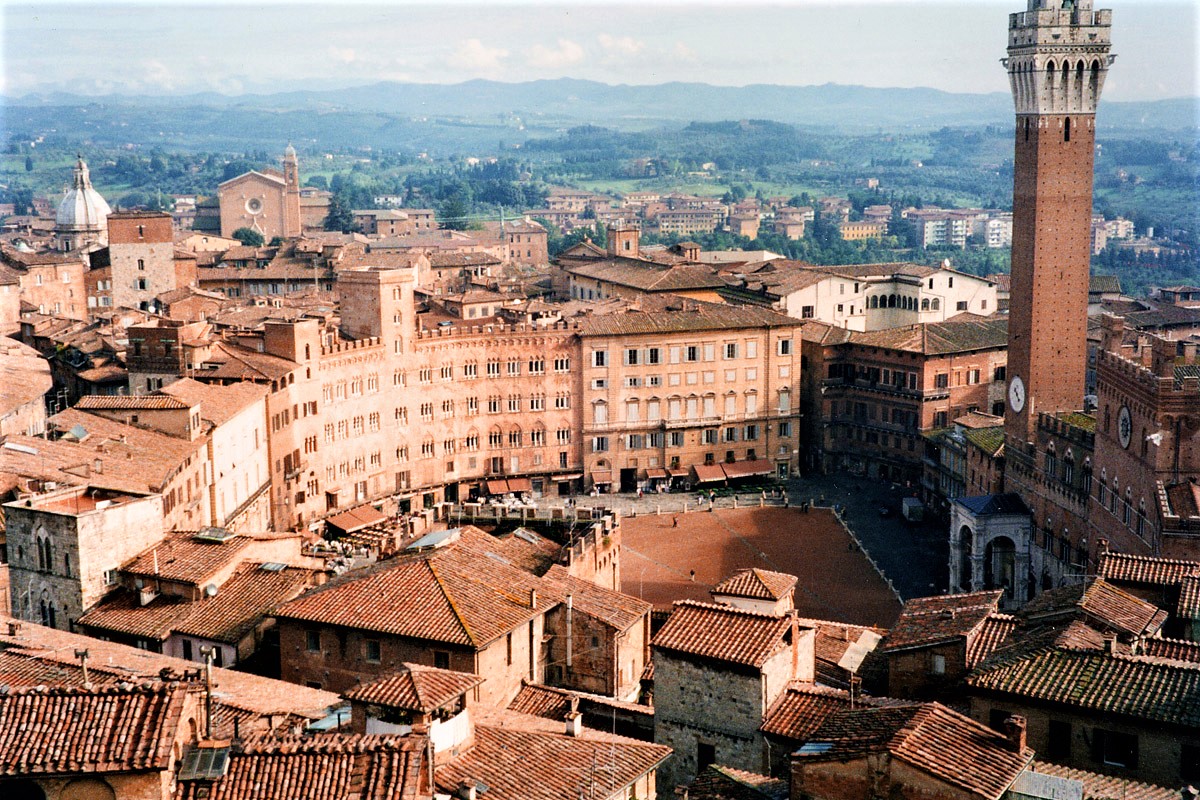
Siena in the heart of beautiful Tuscany is a magnificent medieval city surrounded by massive ramparts enclosing narrow Gothic Streets, numerous palaces, churches, and museums.
The centre of the city is the huge, scallop-shaped, Piazza del Campo, dominated by the red Palazzo Pubblico and its tower, Torre del Mangia. The piazza is the venue for the twice annual world-famous festival Palio delle Contrade featuring costumed processions around the paved piazza with the surrounding houses and palaces decked with colourful pennants. The festival culminates with a dangerous horserace round the pizza with the winner awarded the Palio, a standard bearing the image of the Virgin, the city’s protector. Carnival in Siena takes place during February and with the Palio taking place in July and August. The grand Duomo completed in 1380 with an inlaid mosaic marble floor and fabulous scuptures, houses magnificent frescos and painting by Renaissance masters including Donatello, Ghirlandaio, Pinturicchio, Dietisalvi di Speme, Lorenzo Ghiberti, and Jacopo della Quercia.
Siena is renowned for its cuisine offered by numerous fantastic restaurants located in meandering enchanting medieval streets throughout the historic centre of the city, and is approximately 105 kilometres west of Citta di Castello.
Siena and the spectacular Palio have been featured in many movies including the James Bond film, Quantum of Solace.